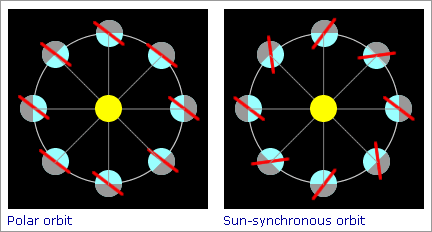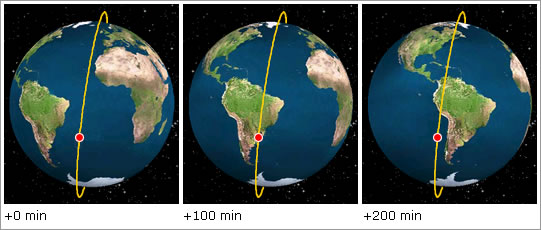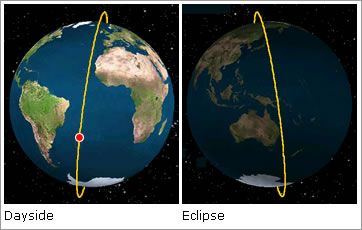In a near-polar orbit the asymmetric gravitational pull of the Earth causes the orbit to precess at almost exactly the same rate that the Earth orbits around the Sun (approximately one degree per day), in turn causing the orbital plane to appear fixed with respect to the sun, or to be sun-synchronous. Orbits that precess are also known as retrograde orbits.

Fig 1.2.1.2.1: Polar orbits and sun-synchronous near-polar orbits during the Earth's year.
Image: AT2-ELS
The constant angle of the orbital plane to the Sun resulting from this precession means that the equatorial crossing time of the satellite, in terms of the local solar time, remains almost constant throughout the year — in fact, sun-synchronous orbits are typically described in terms of their equatorial crossing times. Most importantly, it also means that a satellite can make repeated observations with similar illumination from pass to pass.
This characteristic of sun-synchronous orbits has important advantages for remote sensing from space, since at any given latitude during the satellite overpass the Sun is nearly at the same position whatever the current longitude of the orbital position. This fact, in turn, is important for the subtraction of stratospheric components during the data retrieval procedure.

Fig 1.2.1.2.2: The ENVISAT orbit at 100 min intervals
Image: AT2-ELS
Satellites in near-polar orbits pass through a dayside and an nightside part of the orbit. For both ERS-2 and ENVISAT the dayside part of the orbit corresponds to the descending pass, that is, the transit from north to south.

Fig 1.2.1.2.3: Dayside and nightside views of the ENVISAT orbit
Image: AT2-ELS
Because the orbit is sun-synchronous, sunlight always comes from the same direction relative to the plane of the orbit. However, as the satellite moves along the dayside part of its orbit the incident angle of the sunlight falling on it changes continuously. Emerging from the nightside into the dayside part of its orbit the satellite will experience a sunrise, and then a sunset when moving back into the nightside; the sun will be lower in the sky as the satellite approaches or leaves the poles.